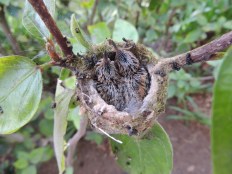CURes is kicking off the new year with another intense season of birdwatching. Just a little over a year ago, previous CURes Research Fellow (2016-17) and current Graduate Fellow, Erich Eberts, launched a research project that aimed to answer the question: Do nesting female hummingbirds go into torpor? After successfully collecting data during the Spring 2017 season on LMU’s campus, Eberts and the team are back for another hatching season with some useful results and intriguing new questions to pursue.

The idea for this project was conceived at the North American Ornithological Society conference in August 2016, when Eberts initially thought to use thermal imaging for hummingbird research. The LMU campus has a large hummingbird population, which CURes had already been monitoring for some time when Eberts proposed his question about torpor in nesting mothers. Torpor is a temporary state of reduced activity, metabolism, and body temperature, which certain animals will enter to conserve energy and survive in harsh conditions. Whether female hummingbirds use torpor during nesting is a matter of debate, as there having only been rare observations of torpid hummingbirds in a handful of studies. However, these studies used temperature probes and other invasive methods that are more likely to disturb the natural activity of a hummingbird. Eberts wanted to see if hummingbirds would more readily enter torpor under less invasive observation, by using thermal imaging to capture data.

The project, which is currently titled “Thermal Imaging Nesting Torpor,” monitors active hummingbird nests across LMU’s campus using video and thermal cameras. At the start of the Spring 2018 semester, research team members Kaitlyn Yee and Amy Weber began their search for new nests. This task is more difficult than it may seem. Hummingbird nests are about the size of a golf ball and are usually built in sheltered, hard-to-reach places (e.g. deep in bushes or high in trees). Although this protects the nests from predators, it also makes them difficult to locate and monitor. Once a nest is discovered, its status and location are recorded and tracked in a database. In one month of searching, the team found 21 nests on-campus, 18 of which are currently active. This is a considerable improvement from last season, in which the team found 24 nests in four months of searching.

Thus far, the collected data suggest that the hummingbirds on-campus do not use torpor when nesting. Eberts’ findings are in agreement with most of the scientific community, but there are still some interesting questions to pursue. This year, Eberts decided to also explore the potential for microhabitats on-campus, which could have a major influence on his research. In addition to monitoring the body temperature of hummingbirds, the team now measures the distance of the nest to surrounding objects, the intensity of wind in the nest’s location, and the amount of sunlight that the nest is exposed to. This information may give insight into hummingbird behavior, nesting habitats, and physiological changes throughout the day.
Eberts is currently based in Toronto, where he is continuing his study at the University of Toronto Scarborough with his research partner, Anusha Shankar. In a lab setting, Eberts and Shankar are able to measure a hummingbird’s respiration throughout the night, from which they can extrapolate about the bird’s metabolism. This research, combined with the research at LMU, will be the subject of Eberts’ master thesis.
The hummingbird project is just one of the many projects at CURes that give students the opportunity to conduct research with professionals in the field. The Coyote Assessment at Long Beach is also currently underway; additional information about that project will be posted soon. Learn more about student research opportunities on our website, and stay tuned for more updates about what we do here at CURes!
Written by Liam Chamberlin (CURes Media Intern)